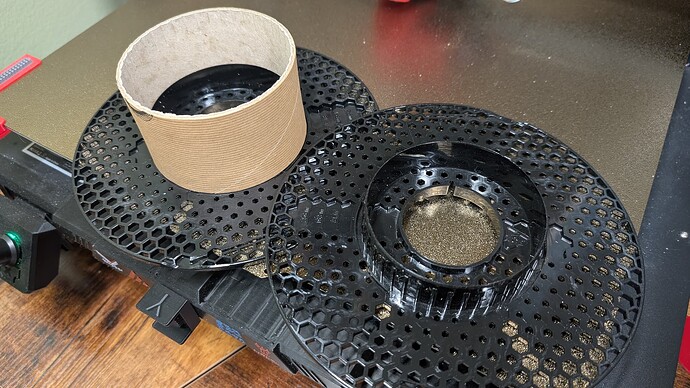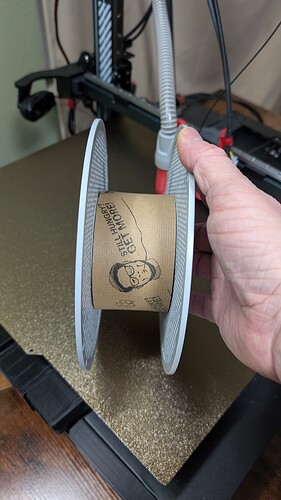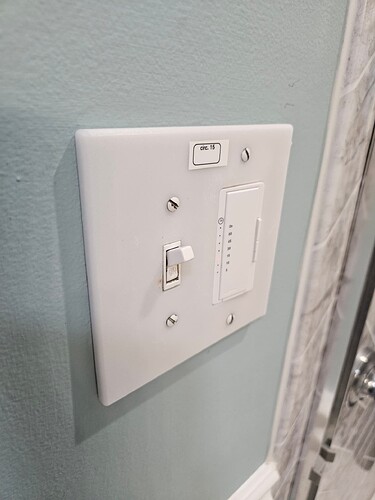Prusa makes a filament, PETG V0. i would like to get this (they have a UL certificate for it), to make fire resistant parts, electrical plates, etc.
QUESTION, fitting this into the BAMBU AMS, or the new bambu AMS HEATER/dehydrator
I’ve read about incompatibilities of prusa spools versus bambu.
SO, GENERAL questions about using PRUSA stuff on bambu
QUESTION - do the REFILLS have the same diameter as bambu, so that the refill could be inserted, onto the bambu spool, and the WIDTH would be OK (I can make spacers to fix the diameter issues)
QUESTION - if refill is not available from prusa, CAN the prusa spool be separated, like the bambu one, and the FILAMENT WITH ITS CARDBOARD CORE, be transferred to the bambu spool (again, concerned with width, so that it FITS onto the bambu spool)
any feedback is appreciated
LAST RESORT, i could respool it, i made a respooler, but i’d rather use one of hte above methods if able.
1 Like
I’ll try to answer all your questions:
-
The Prusament spools seem to be inconsistent due to the way they are made. They are two plastic sides pressed on to a cardboard center. When I read your post I tried two different spools, both 1KG Prusament PETG. One fit the AMS perfectly, the other was slightly wider and was too tight to turn when the AMS tried to pull in the filament. So if you ordered the PETG V0 it would be the luck of the draw if it would fit.
-
The Prusa spool CAN be seperated. If you work your way around one side pulling slighly, eventually the plastic will come loose from the cardboard center. The width fits perfectly on a Bambu reusable spool. The circumfance is much larger than a Bambu refill.
One other thing to think about, did you see Bambu has a fire retardant PC?
2 Likes
WOW, first answer, and perfect answer !!
re: Circumference - I make cardboard spacers for the Duramic, (corrugated cardboard works well), just needs to be approximately centered and balanced, so htat the cardboard does not rotate around the plastic.
re: the bambu PC FR - i saw that, but i don’t think bambu has a UL rating for it, whereas the Prusa has a UL certificate for it. I will investigat3 more before buying.
EDIT, it DOES look like they have a UL rating for this ! and they have it in white. It is a PC material - any thoughts on the PC FR material, versus the Prusa PETG V0 material, for strength, heat (melting) resistance, etc? my main goal is the UL rating, for safety, for outlet cover plates and other electrical stuff
EDIT #2, it looks like bambu TESTED the filament for UL standards, but did ot get an official UL certificate (another post reviewed this)
I’m still looking into it
Again, thaks very much !!
1 Like
You’re very welcome! I wish I could give you more info but I’ve never tried either one. If you do end up getting either (or both) please let us know what you think.
i have just ordered the bambu AMS HT dehydrator / heater. I have to set up virtual credit card for prusa, will do that tomorrow, and order their PETG V0 filament. I will test it out, have two outlet plates to print, and will provide feedback on it. there is one other post on here that had some settings for the PETG V0, i’ll start with them. it seems somewhat easier ot use the PEGB V0 than the PC FR filament, from some posts.
I print parts for my cockpit using PC FR because of its heat resistance and fire-retardant properties. I would never consider using low-temperature materials for this, as it’s easy for the cockpit to exceed 50°C during the summer while parked at the airport.
Bambu Lab PC FR: UL 94-2023 V-0 Flame Retardancy
thanks for reply !
I ordered the PRUSA PETG V0, am going to try that first (did not require as high a heat, and had a UL certificate, even though that was restricted to a prusa printer… Bambu has a testing certificate, that they did the tests to match the UL requirements, but not an actual UL certificate. That all may be a mute point, both filaments have the fire resistance, and that is my goal. again, thanks !
As long as the temperature never exceeds the typical deformation point of PETG, you should be fine. I personally can’t use PETG for anything in my cockpit, and PC FR is easy enough to print on the H2D or even the X1 Carbon. I also don’t experience the dreaded stringing that can occur with PETG.
Feel free to share some photos once you’ve had a chance to test it out!
Read the test report here: https://cdn.shopify.com/s/files/1/0380/5149/files/Bambu_PC_FR_UL_94.pdf?v=1738949860
I don’t have anything to add, but would like to mention that I strongly appreciate your attentiveness to seeking materials that actually hold the UL certificate.
For safety-critical systems, Marketing claims aren’t worth the bytes they are written on. Bambu’s certificates are from a chinese mainland authority, not from international standards organizations like UL. Who knows what rigor they hold to, or how compliant their org is to an envelope of cash included in the samples.
1 Like
thanks for reply .
while bambu may have gotten legitimate testing, i feel more comfortable wiht an official testing label, as i’ve had problems in the past with things that were supposedly “certified-compatible”, and did not have actual certification, and had issues.
I believe bambu, and others, are working to getting quality materials to fit these standards (reviewed several other brands of materials), and my son has used some of bambu’s high temperature filaments with good success.
if you really want to see an interesting test, get some GE Silicone II. (2). They make this in many variations, and ONE of them is actually an electrical insulation tube. PER the company (I had corresponded with them), many of the formulations are similar, but are tweaked for different applications. I was making mason jar lights, and had a porcelein fixture on the top, and it was to hang in a barn. so i wanted some of the electrical insulator stuff. the fire properties of this are that it turns to ash with flame, and won’t conduct the flame. SO, I TESTED it, created a string of it, and lit it. INDEED, it was amazing to see how it STOPPED the fire; when in the flame, it had a blip of a flame, but was turning to ash with the flame, and not letting any flame really advance.
NOW, for people gettnig these V0 filaments (including me), it would be interesting to just see HOW they burn/or/don’t burn, with a similar test, and i may do that with the first piece of filament, and comapre it to some PLA, and PETG. and really see hat protection i’m getting/not getting 
Since I use PC FR in my cockpit, I have probably done more testing on these materials than Mr. Prusa himself. Both seem to work, but — and this is a big but — PETG simply cannot withstand heat anywhere near what PC can handle, no matter what you might think. If you need a material that can resist heat while also being fire retardant, PETG is the wrong choice.
In a normal car, during an average summer, you can easily get hotspots exceeding 70°C, and that will, without a doubt, damage PETG — even if it’s certified. As long as you’re confident about where and how you’re using the material, and you feel safe with your decisions, you can of course choose whatever you prefer.
That said, to be honest, with the right connections, it’s possible to buy certifications too — so a certificate doesn’t always guarantee that everything was done strictly by the book.
thanks for reply ! and, in this market, as you said, your personal experience has much more weight than a piece of paper with a test on it.
re: heat, agreed, the PC has more heat tolerance than the PETG, but for me, and my home use, the PETG will be adequate.
My son is using some of the nylon products for some car accessories, and it has been doing well. and it is good to hear that the PC filament can withstand actual tempeatures, such as the cockpit applications.
These threads are well appreciated, to give people some real world examples of how this stuff works !
additional question - do you use other filaments in your dryer; what is max you go to; and do the bambu spools stay intact? thanks
I have three types of filament dryers:
– EIBOS, which can reach up to 70 °C and rotates two spools
– AMS2 PRO, with a max of 65 °C
– AMS HT, capable of up to 85 °C
And one lab oven that goes up to 300 °C.
So far, all spools have survived every drying cycle without issues.
OK, got the PETG V0, Prusa. Printed out 5 electrical plates. AMAZING ! I found some settings in PRUSA for what to set the filament as. I made a custom filament setting, it is inside this bambu custom setting that i used to do the plate. other than s small defect in teh first layer, this did very well printing,and is very sturdy as a final print. TEXTURED PEI plate, as this stuff sticks to the Plate. But overall very satisfied with its print.
NOTE, this filament is slightly transparent for light; a cool white color, not a solid white. I can live with it as is, looks good.
Elec-Switch-Wall-Plate-PETG-V0-filament.3mf (70.5 KB)



